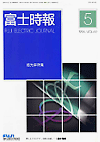FUJI ELECTRIC JOURNAL Vol.69-No.5 (May/1996)
 |
Photoconductors |
Present Status and Prospects for Fuji Electric's Photoconductors
Michihiro Kitazawa, Katsuhiro Sato
For electrophotographic hard copy devices, plain paper copies and nonimpact printers are used. Their market is growing with the advantages of high speed, high image quality, and compatibility with plain paper. The photoconductor is the core component of these electrophotographic devices. Having put selenium photoconductors on the market in 1973, Fuji Electric has expanded the product line. Now the mainstream of the line is the organic photoconductor which has remarkably improved in performance and quality. This paper outlines the present status and trend of the electrophotographic field and introduces Fuji Electric's line of photoconductors and its attitude for the future.
Organic Photoconductors for Printers
Shin'ichirou Nishimaki, Toshiki Obinata, Yoshiki Yokoyama
With the remarkable progress in communications, electrophotographic page printers are required to have higher picture quality. Fuji Electric has developed the high sensitivity type 8E photoconductors for page printers following the low and medium sensitivity type 8B. The improvements are (1) new function materials, such as carrier generation layer (CGL) and carrier transport layer (CTL), developed to improve sensitivity (2) long life due to the selected CTL resin binder fit for the printer process (3) high reliability in the operating environment (4) construction with safe chemical materials.
Organic Photoconductors for Plain Paper Copies
Mitsuru Narita, masahiko Kasahara, Yasushi Iguchi
Organic photoconductors for plain paper copiers (PPCs) have rapidly come into wide use because of safety, small-sized diameters, cost reduction, and unitized design for the processes around the photoconductor. Recent demands are operational stability in the working environment, high sensitivity, and high durability. Fuji Electric has put on the market organic photoconductors for PPCs that can meet these market requirements. This paper particularly introduces the organic photoconductor for high-speed PPCs which is high-performance and applicable to wider range of PPCs
Large-sized Organic Photoconductors for Plain Paper Copiers, Plotters, and Printers
Kunio Otsuki, Akio Arai
Among electrophotograhy-applied devices, plain paper copiers (PPCs) for large drawings such as A0 and A1 and plotters and printers as CAD/CAM/CAE output devices are in rapid progress. Since the development of selenium photoconductors, Fuji Electric has continued developing large-sized photoconductors (in diameter and length) for the heart of these devices. On the basis of its experience, the company put on the market large organic photoconductors for PPCs, plotters, and printers. The line of organic photoconductors is increased by adding wet development use to dry development use. Manufacturing size is 60 to 180mm in outside diameter and 340 to 1,000mm in length.
Selenium Photoconductors for Printers
Susumu Takano, Kazuya Adachi, Shigemichi Itoh
Selenium photoconductors have been used as the print member of plain paper copiers and printers using electrophotography for many years. Among them, the printers increase in demand because of the merit of high quality, high speed printing. This paper outlines the selenium photoconductor for printers which steadily extends the market to meet recent office automation.
Material Technology for Organic Photoconductors
Shin'ichi Tamura, Osamu Nabeta
Because the organic photoconductor has a variety of structure which is characteristic of organic material and so material design and selection can be made suitably, application to nonimpact printers and plain paper copiers (PPCs) with various processes is expanding continuously. On the basis of its organic material design and material synthesis technology, Fuji electric has developed original organic materials and expanded the line of photoconductors fit for printers and PPCs. This paper outlines organic photoconductors developed by the company.
Analysis and Evaluatio Techniques of Organic Photoconductors
Koji Kwaguchi, Masami Kuroda, Haruo Kawakami
Organic photoconductor (OPC) performance greatly depends on the molecular structure of used materials (carrier generation material, carrier transport material, and resin binders), their combinations, and application methods. Therefore, in OPC material development and characteristics improvement, it is important to grasp the relation between the molecular structure of the basic materials and photoconductor characteristics. This paper introduces molecular structure analysis technique for organic materials for OPCs and physical property evaluation technique (carrier mobility and traps) with the analytic result.
Production Engineering of Organic Photoconductors
Junji Fujimura, Yoshio Terasawa
This paper describes key points and technical problems in the production of low-cost, good quality organic photoconductors (OPCs), citing an outline of Fuji Electric's OPC production process. The main OPC production process is
(1) crude pipe formation and surface treatment
(2) pretreatment (in particular, cleaning with liquid)
(3) film coating (paint mixing, painting, and drying)
(4) assembly and test (automatic visual inspection)
Operating all process under integrated control is a condition to produce high-reliability, low-cost OPCs.
(1) crude pipe formation and surface treatment
(2) pretreatment (in particular, cleaning with liquid)
(3) film coating (paint mixing, painting, and drying)
(4) assembly and test (automatic visual inspection)
Operating all process under integrated control is a condition to produce high-reliability, low-cost OPCs.
2.5kV, 1kA Powe Pack IGBT
Yasukazu Seki, Yoshikazu Takahashi, Masami Ichijoh
This paper introduces a high power (2.5kV, 1kA) reverse conducting IGBT (Power Pack IGBT). This is a flat packaged IGBT with a pressurized contact construction. Compared with an IGBT with a modular construction, the Power Pack IGBT is not only compact with high packing current density but also highly reliable in operating conditions. It proves good characteristics for on-state voltage and turn-off loss as a 2.5kV class IGBT as well as high withstanding capability in the severe tests such as power cycle, heat shock, and high temperature DC bias tests.

